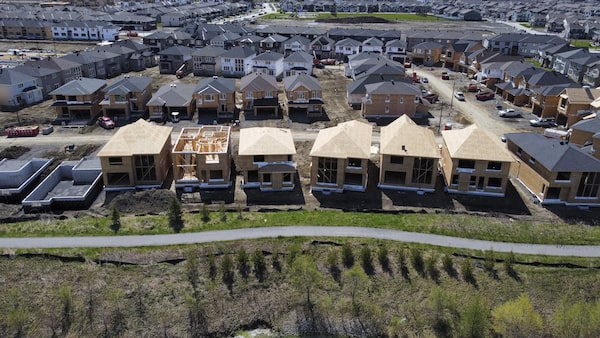
New homes are built in a housing construction development in the west-end of Ottawa on May 6, 2021.Sean Kilpatrick/The Canadian Press
The best collection of ideas to fix Ontario’s broken housing market landed in February, three months before the current provincial election. The report was commissioned by Premier Doug Ford, presented to Premier Doug Ford – and largely shelved, by Premier Doug Ford.
The task force behind the report, chaired by a bank executive and including a range of voices and expertise, delivered a bold and long list of policies to get more housing built, in the right places. The plan aimed to ensure a reasonable amount of new density in the province’s cities and suburbs. The headline-grabbing goal was for 1.5 million new homes over the next 10 years – nearly double the current pace.
Beyond the call for greater density and more homes was the question of affordable housing. The term can be nebulous – even higher-income young people are struggling to buy or rent in today’s market – but it normally means housing offered at prices below the prevailing market rates, for people of middle to low incomes.
Strategies to drive market affordability ran through the Ontario task force’s report, such as automatically allowing buildings of up to 11 storeys, with no parking minimums, on streets with transit. But for deeper affordability, from purpose-built rentals to social housing, the report said government would have to do more: “We cannot rely exclusively on for-profit developers nor on increases in the supply of market housing to fully solve the problem.”
The report’s proposals included pouring more provincial dollars into affordable housing, perhaps from the $5-billion-plus Ontario rakes in annually from the land transfer tax. Other ideas included the use of public land, and lower taxes and fees on affordable housing.
Ontario election today: Party leaders focus campaigns on GTA
In the Ontario election, 1.5 million ways to fix housing. Will it happen?
Canadians are understandably angry at the Bank of Canada. Here’s what it can do
Canada used to be good at building, affordable and in general. During the boom of the 1970s, Ontario erected twice as many homes in total, per capita, as today. Canada saw an average of roughly 25,000 affordable homes built each year from the late 1960s to the early 1980s – more than 10 per cent of all construction. Ottawa was a key backer. The federal Liberals brought Ottawa back into housing but the goal of building 16,000 affordable homes a year is half of what the country did, adjusted for population, a half-century ago.
Mr. Ford’s current plan focuses on cutting the time and cost to get new affordable housing approved and built. That’s important, but it’s not enough. The Ontario Liberals and NDP go further. The Liberals propose a new housing Crown corporation and the NDP a new public agency. In both cases, the idea is to “finance and build” affordable housing. Their plans also include calls for more density. The Liberals and NDP both also back so-called inclusionary zoning, as did the February report. That would allow developers to build more density, on condition of including some affordable units in a project. The City of Toronto has taken a step in this direction, though the trick is getting the incentives and rules right.
Deeper government intervention in affordable housing is necessary. Many analysts have argued that governments are well positioned to fund below-market rental housing, since they can borrow at lower rates than the private sector and carry the debt over decades, supported by even below-market rent payments.
How government money is best deployed is a question. The federal Liberals have focused on a program of low-cost loans to developers through Canada Mortgage and Housing Corp., dubbed the rental construction financing initiative. Last year, however, the Parliamentary Budget Officer questioned the program’s effectiveness and critics argued the price of what’s “affordable” was too high. The Liberals, in the April budget, said they would reform the program.
The key starting point, for both affordable and market housing, is more density. Opponents of greater density often argue that new housing ends up being too expensive. It’s true that the homes in a new fourplex that replaces a $1.5-million detached home would still be pricey. But more density – more units on each pricey piece of land – will tend to increase each unit’s affordability. And affordability comes with scale, in multiunit apartment buildings versus single family homes, or through assigning a portion of units in a tower.
Reforming Canada’s housing rules – what can be built where – will help make all housing less unaffordable. Get the regulations right, and free-market developers will do much of the job. But in a portion of the market – affordable, lower-income housing – the free market may not be enough.
Keep your Opinions sharp and informed. Get the Opinion newsletter. Sign up today.